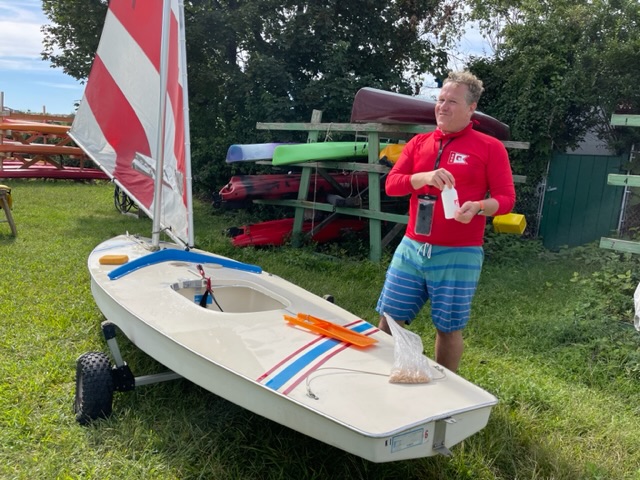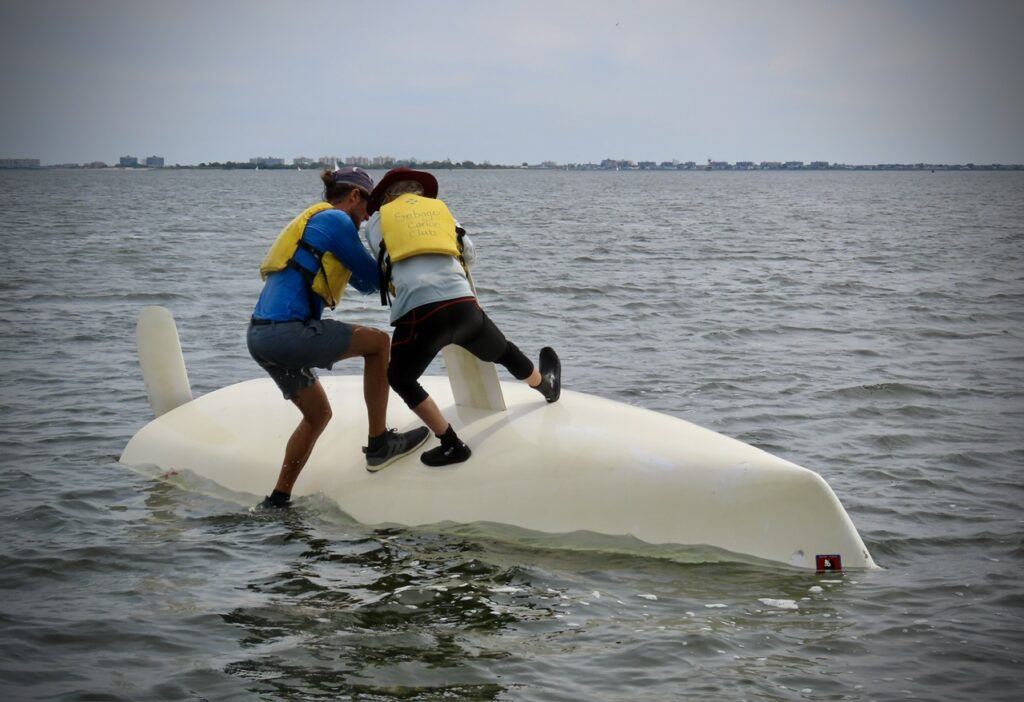The Over/Under on the Dockmaster’s first race in a LONG time as he shows a friend how to sail one.
It’s been a minute since I raced a sailboat, and a few more since I did it in a dinghy. What’s a dinghy?
NB: CLICK ON PICS to defeat distortion and/or blow up (glitch I’m solving that you might or might not see depending on device).
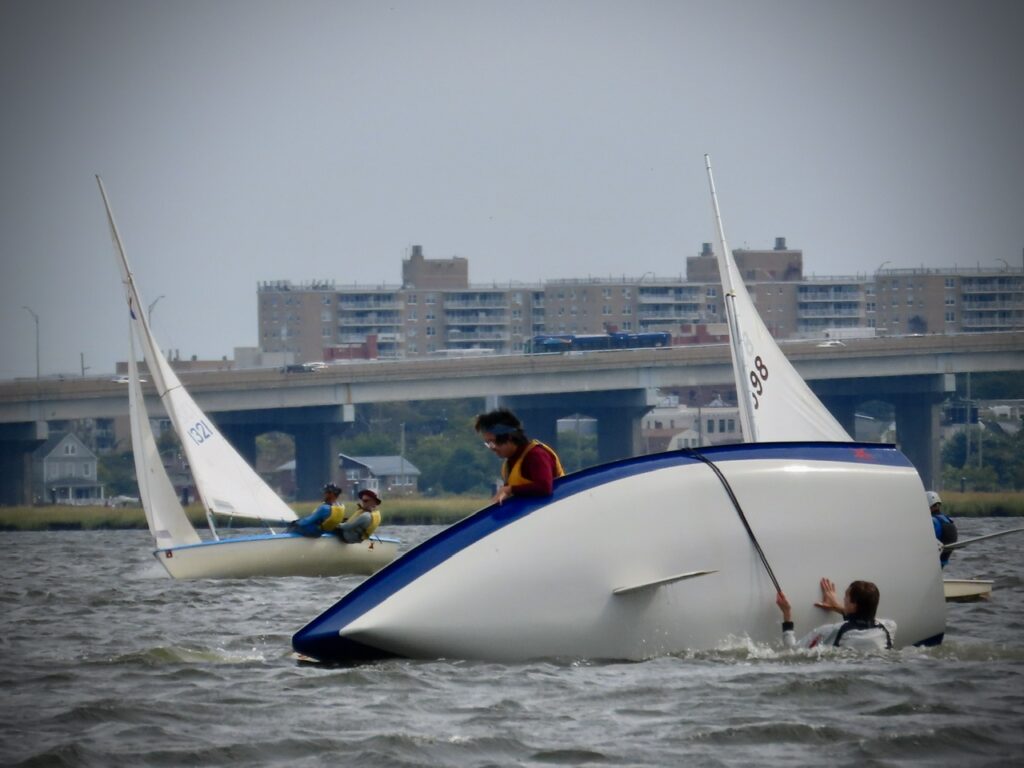
The little ones that flip. Fun; fast. Fairly athletic. (usually) Simple. They’re dry-sailed: put ’em in the water to use, and pull ’em back out when done. Often on a dolly but sometimes by sheer lifting and carrying power.
I used to race two classes of dinghies: Dyer Dhows, and Lasers. Dyers were originally yacht tenders: the kind of dinghy used to go to and from shore when moored or anchored. Somehow, Dyers became very popular in the northeast for “frostbiting,” or winter racing. It’s slightly insane, but yets – I did it, and people still do it today with abandon in Dyers and other classes of boats…
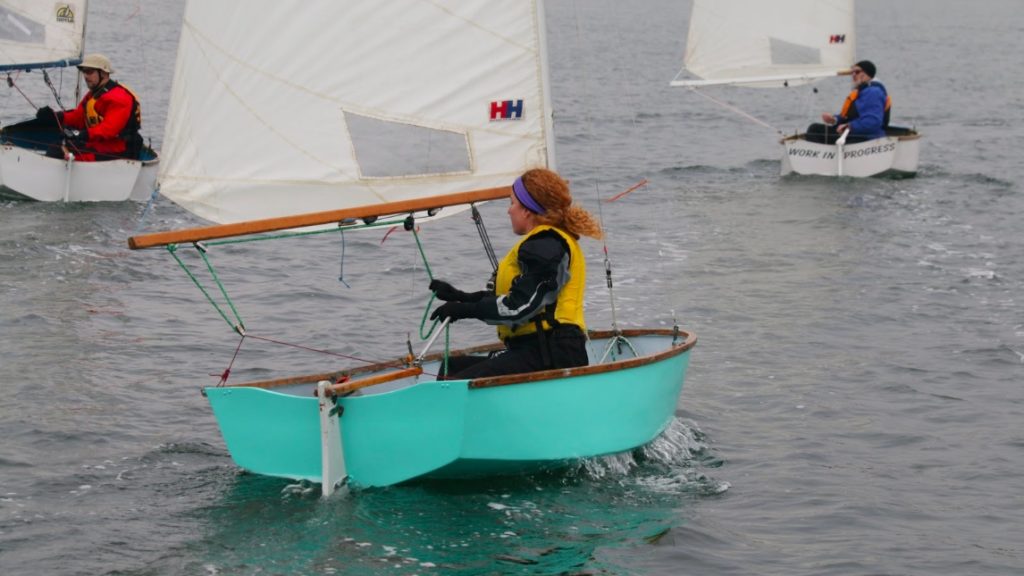
…Including Lasers. I raced them in the early to mid 1980’s. My sail number: 101670. One doesn’t forget it. Now, they’re popular for frostbiting, but not when I started racing Dyers.
“Laser: there is no substitute.”
Steve Card (Owner & Author)
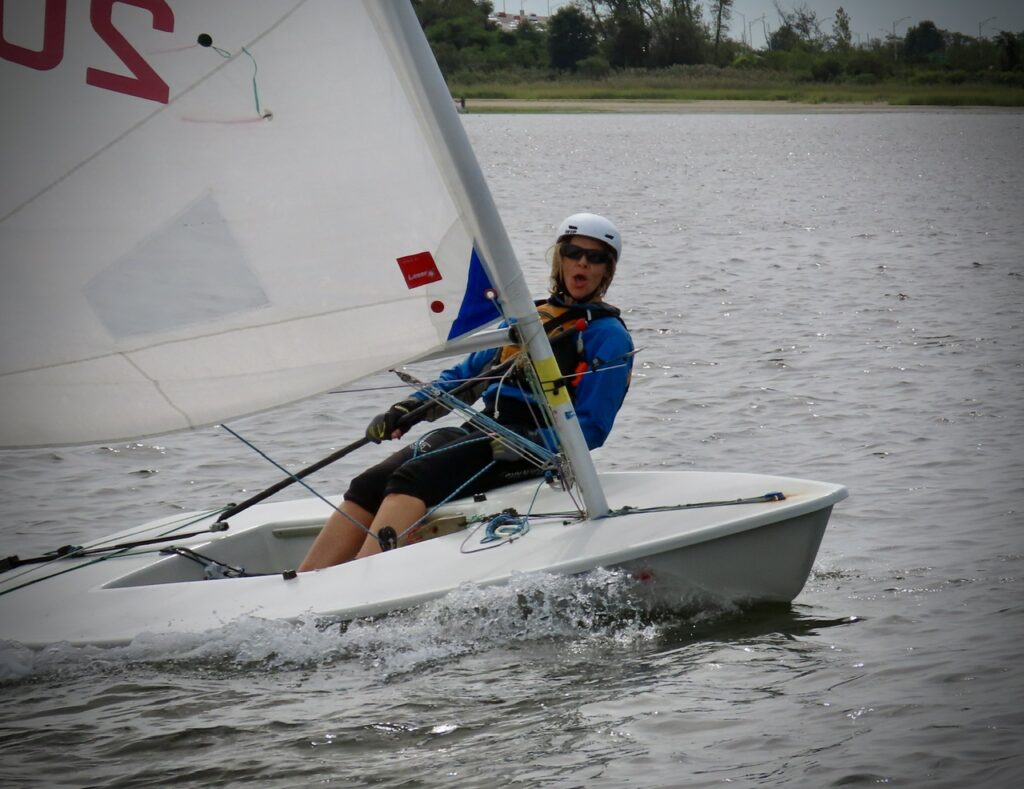
I had some success with Dyers at the local level and Lasers at the district level (#8; NYC/Long Island). I raced the full-size rig, as that’s what people did then. I was way too light for it then, and am still too light for it despite not being as rail thin as I was soaking wet back then. I got away with it as LIS is a light wind region, and maybe I had some talent and ability. If nothing else, I could move fast in the boat.
But now, I’m a member of the Sebago Canoe Club, sailing in Jamaica Bay near the Atlantic Ocean. With wind! Much more wind. So, while I’ll get out the full rig eventually on lighter days, I’m now sailing the Radial rig which is around 20 square feet smaller than the standard rig.
But, I’ve just been sailing around. I mentioned something about a race, didn’t I? That was on a Vanguard 15, a boat I’d been super excited to try but never had access until I joined Sebago. Then I was able to get out and just sail around, and do some casual pick-up racing with other members in Vanguards and other boats. When they announced the annual Sebago Cup, I signed up immediately for the club’s one Vanguard 15 and, as two other members own their own, we had a ‘class’ with awards to follow!
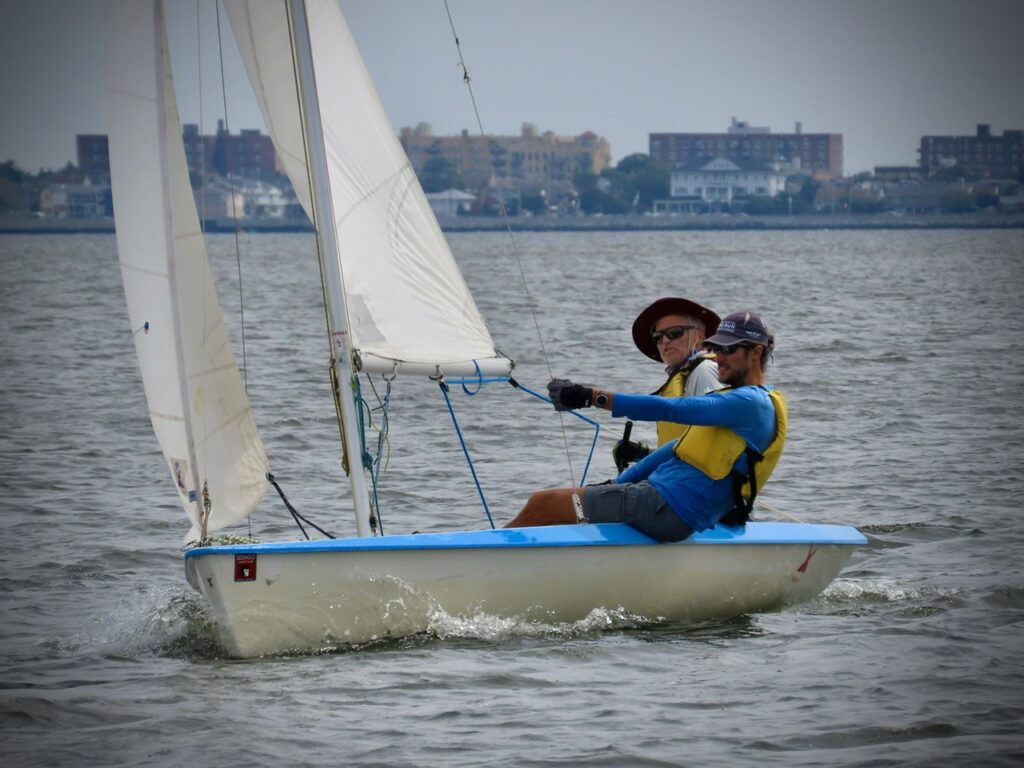
So did Lasers and Sunfish, which comprised all the other boats racing. Sailing at Sebago is about Sunfish first, and Lasers second. (They do, of course, do a lot of paddling – mostly in kayaks but also canoes.) In the Sebago Cup, all are invited, and it’s open to non members as well. It’s a casual, fun, long-distance race, rather than a series of shorter races constituting a ‘regatta.’ One start; one finish. Lots of time in between to try to sail fast and smart.
I used to race competitively and train for it. Now, it was supposed to just be fun. Great! I would have fun trying to win, and try not to care about how I finished. This is what I’d been looking for in racing for awhile but not finding a fit. Often, people said they didn’t take it too seriously, and just having fun, etc. “Our boat isn’t competitive in our division unless it’s really windy; heavy Scandinavian design,” went one explanation. That one, and every other time I heard it, it wasn’t as advertised.
But this time, I’d only have myself (and possibly my crew) to blame if it wasn’t.
The Sebago Cup happens every September and has a good turnout. This time, we had 16 competitors and a couple of boats that sailed along but specifically not competing (traditional designs rather than high-performance skiffs or dinghies). All members are strongly encouraged to attend, and it’s supposed to be fun/casual. Plus, there’s a banquet afterward! What’s not to love?
I signed up with another Steve in the club who I’d met before. When we got closer to go-time, the forecast was kinda rough. Steve didn’t want to go out in a gear buster, especially as he’d never sailed the Vanguard before and was, like me, only recently back in dinghies. So, I put out the word, and found Paolo, one of my clients from the Sailing Center. He’s tall, young and fit. I figured he could hike all day! (‘Hiking’ in this case means leaning out over the boat with feet under a strap to help lever the boat down.)
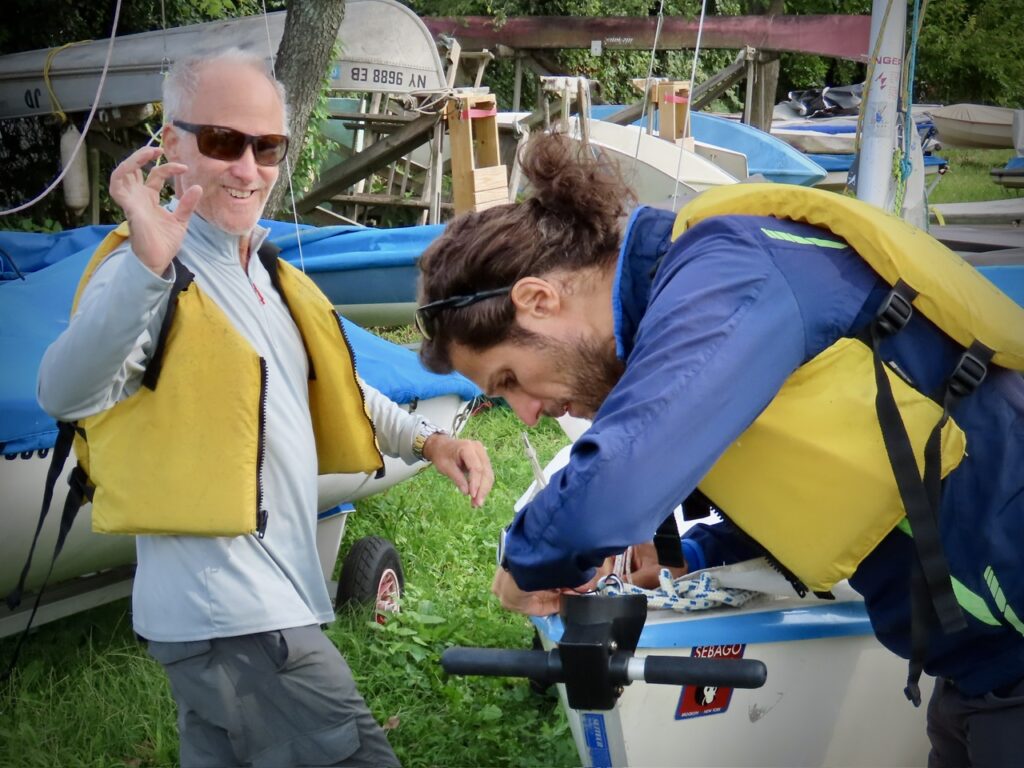
While Paolo is a fairly experienced sailor, learning in Italy and continuing with his cruising education here in the States, he was never on a sailing dinghy in his life. Did some bareboat charter cruises on his own, including at our favorite locations (Croatia and Italy). Got on the dinghies on those trips: the kind to motor you back and forth from your yacht. Not sailing dinghies.
So what? Perfect excuse if I tanked, right? But really, who cares? I had nothing to prove. I just want to participate and have fun racing, especially given that we had multiples of three different classes of boats to make it super interesting.
They almost called it due to the forecast as of the night before, and they could have made that decision last minute. But, they went with it, and it was fine. Got windy at around 12:45, earlier than anticipated, with winds in the upper teens to maybe 20 a few times, but then also calmed down toward the end of the race.
It was FUN! More like one of Sebago’s cruises in Jamaica Bay than a race; main difference is that we didn’t stop for lunch on one of the J-Bay islands. No one yelled at anyone else. Maybe on one of the other Vanguards between skipper/crew, but if so, we didn’t hear anything. One woman had music on softly and we chatted to confirm as we sailed side by side on one leg of the race.
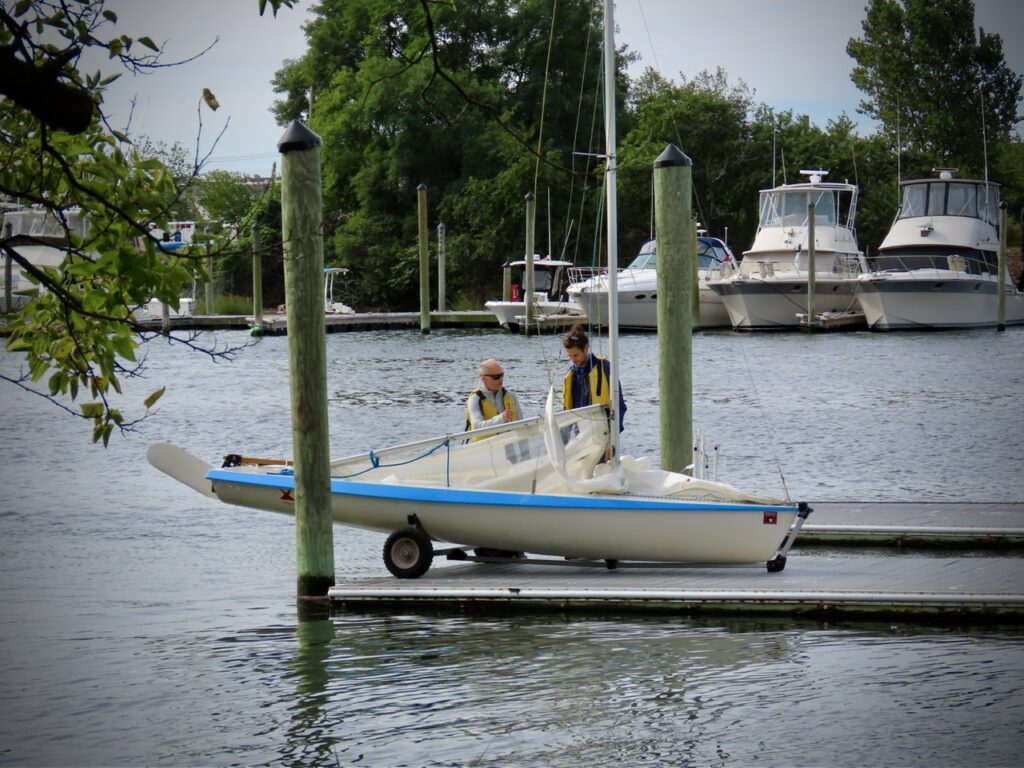
Paolo and I arrived early, got the boat rigged, and dollied it down to the dock early to avoid the rush, dangling it off the dock. By the time we were quite ready, we were a little behind so had to catch up as most of the fleet was already headed out, but all good.
I’d hoped to get out early enough to do some warm up with him. Sailing out of the long, narrow Paerdegat Basin to Jamaica Bay was a start, but we needed some room to zoom and also assess the starting line and make a plan for that. I’ve always told anyone who would listen that I’ll go race with anyone – total beginners at racing, casual veterans, what have you, with two caveats:
- Don’t expect more out of the race than what you bring in to it – experience, practice, and also talent.
- Have a plan for the start. I don’t care if you fail miserably at it – just have one and try to execute it. See how it goes.
- Have fun trying to win the race!
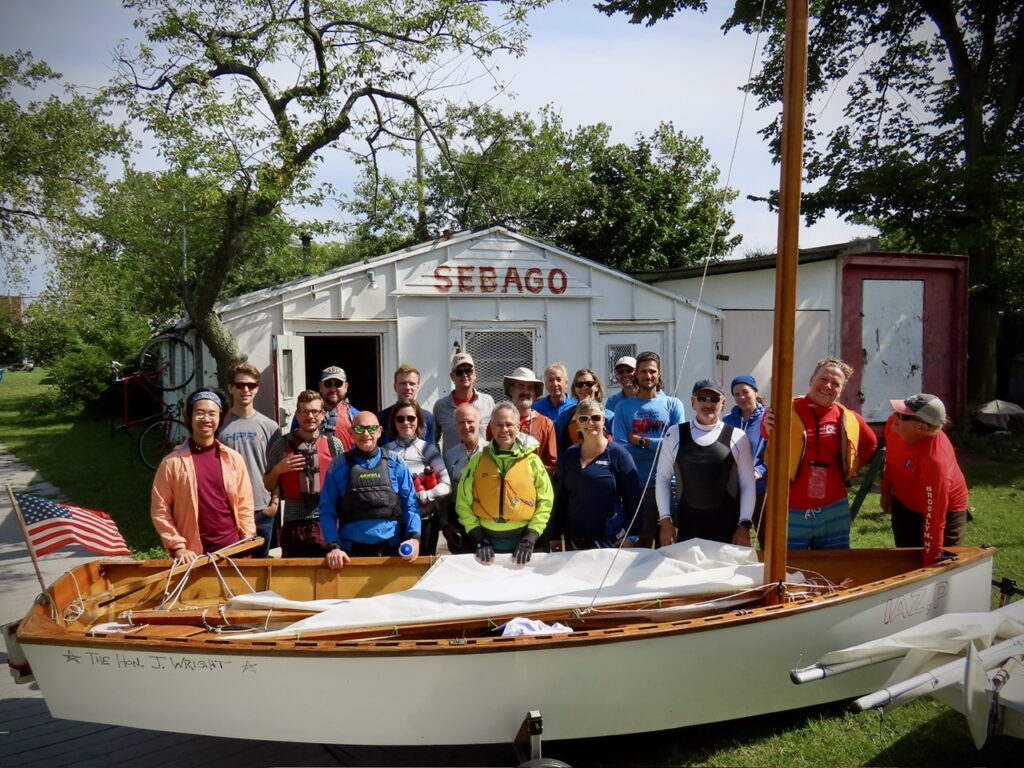
We got out there, ran the starting line, ID’d ourselves to the Race Committee (which included Howard, a grad/friend of the school from awhile ago who joined the Club the same day I did! I tried to get Paolo to hike, but he wasn’t having it at first. Later, I realized that part of it was his proportions. Long and tall don’t work so well in a Vanguard 15. Hard to fit in the hiking straps. But, he was also simply new to it, and the wind was all over the place. Not good conditions for a first timer. But, he did it.
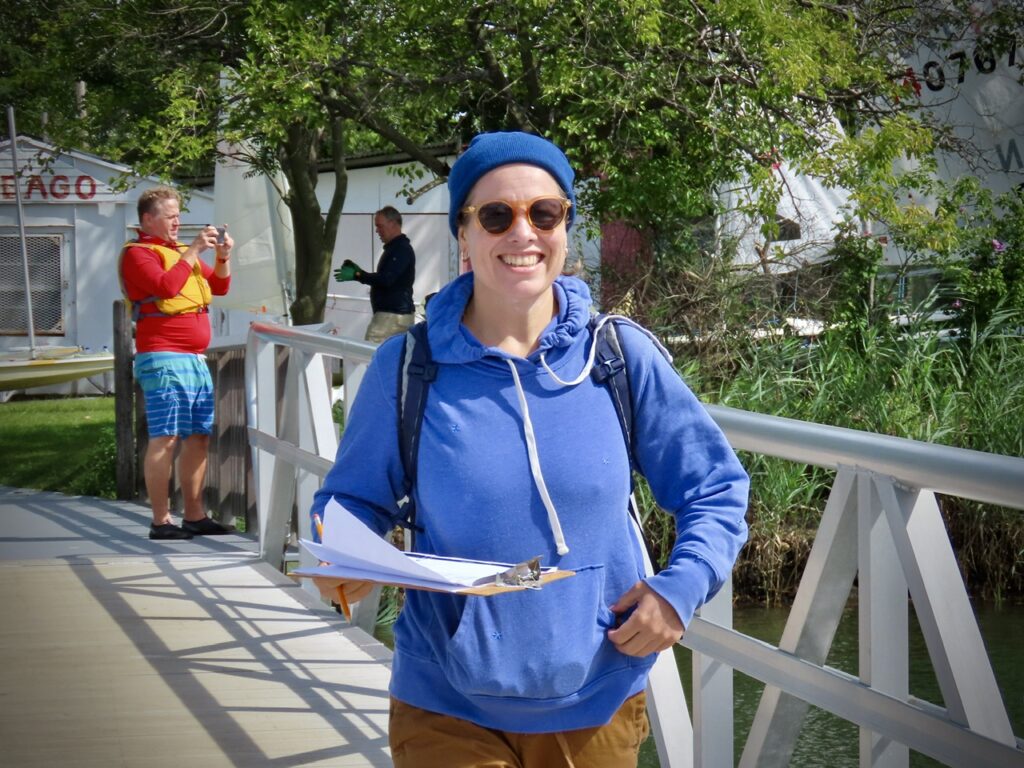
We took a quick break while waiting for the automated starting sequence horns, and hove to while taking what would likely be our last sips of water until after the race (which we figured could be as much as two hours). Next thing we knew, we heard the RC announce “one and a half; one and a half” on the bullhorn. Not only was there not a 3-minute countdown (it was only 2), it had started before we knew it!
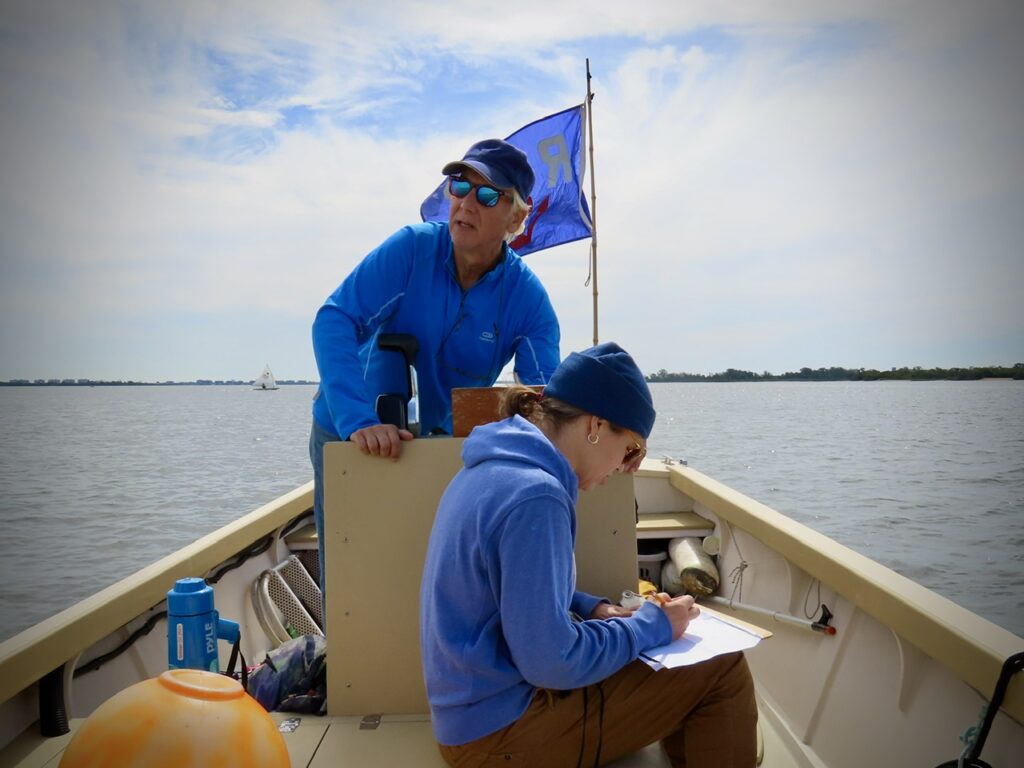
Now, were were going to barely make the start and have little to no control over our position. I’d decided to come in fast on starboard tack for the pin end, as it was a downwind start and this should have given us plenty of room to dodge any leeward boats by forcing port-tackers out of the way, but no. That ship sailed.
We crossed the line. But, nearly last to do so. So it goes…
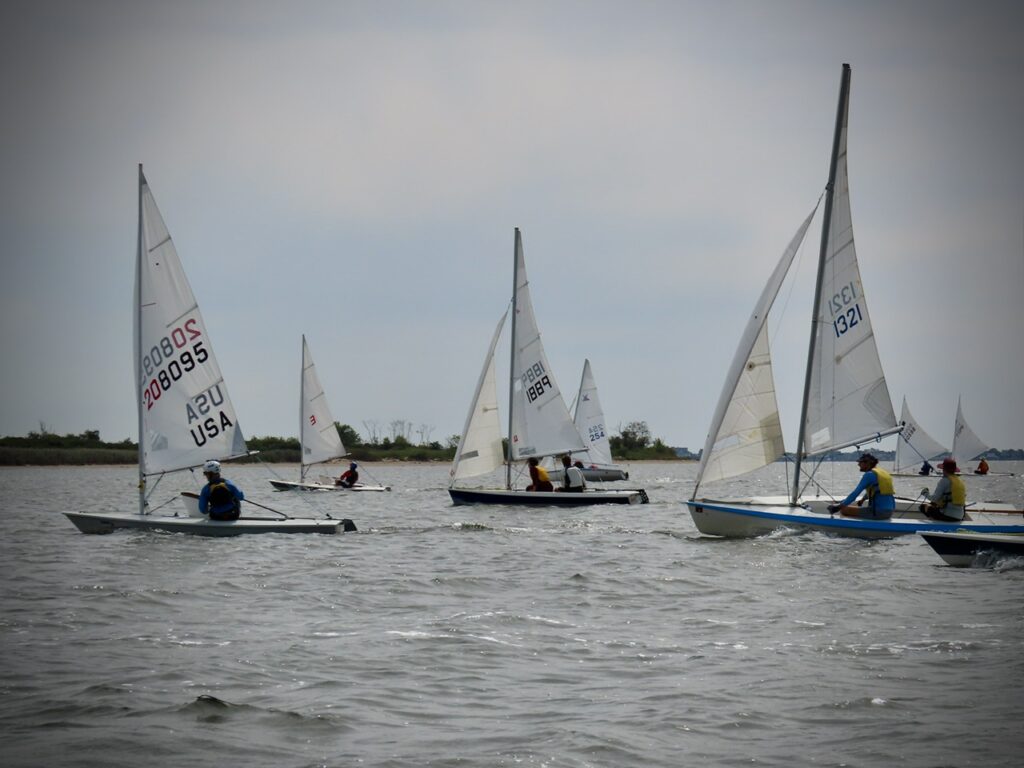
And off we went! Now, we could just have fun attacking downwind and see how much ground we could re-take. I’d been getting a reputation for being fast; I did well in both the Vanguard and Laser in mock racing with other members. On the one ‘cruise’ I did, I left the lunch stop last but passed the whole fleet on the way back before heaving to to stay in sync and keep an eye out for other boats (safety first; Sebago is very safety conscious). So, I figured I could gain some ground.
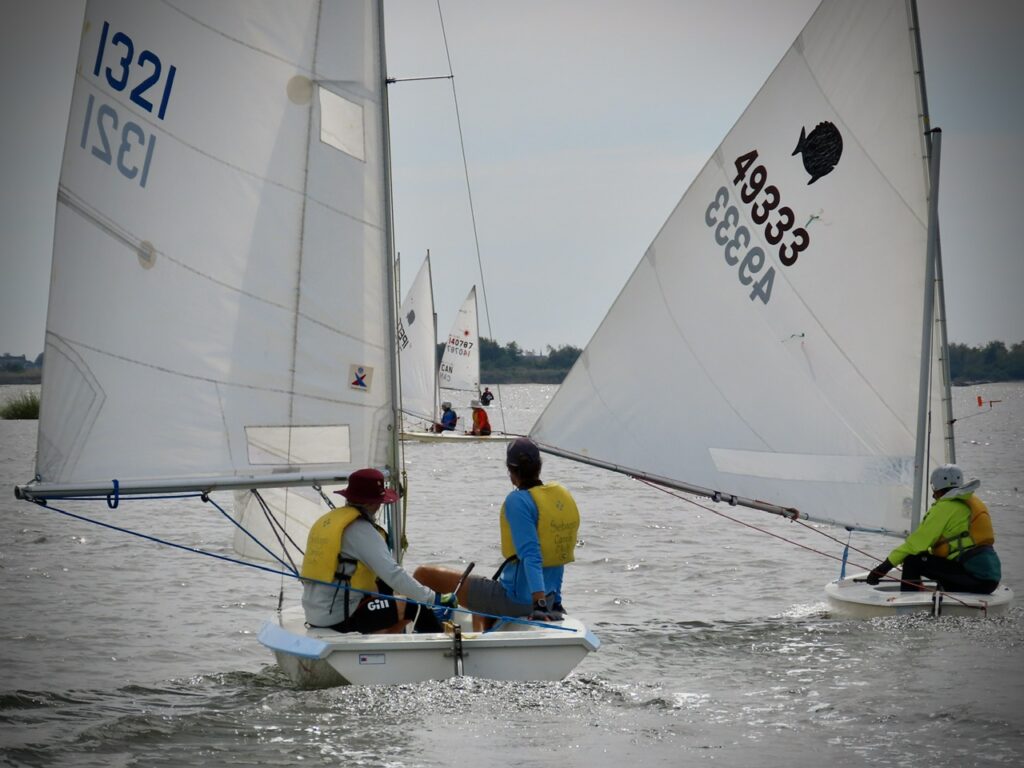
At first, not so. Surprisingly slow; kept pace more or less but couldn’t really gain ground. Then lost some. Soon, however, Paolo and I agreed there was more wind toward shore, on the left side of the first leg, so we headed up to intercept it first and BAM. We got up on a plane and started gaining ground. But, it didn’t last, and of course the wind reached others sooner than we’d hoped so they gained back. But, by the first rounding, we were closer to mid-pack than nearly last. We were doing something right.
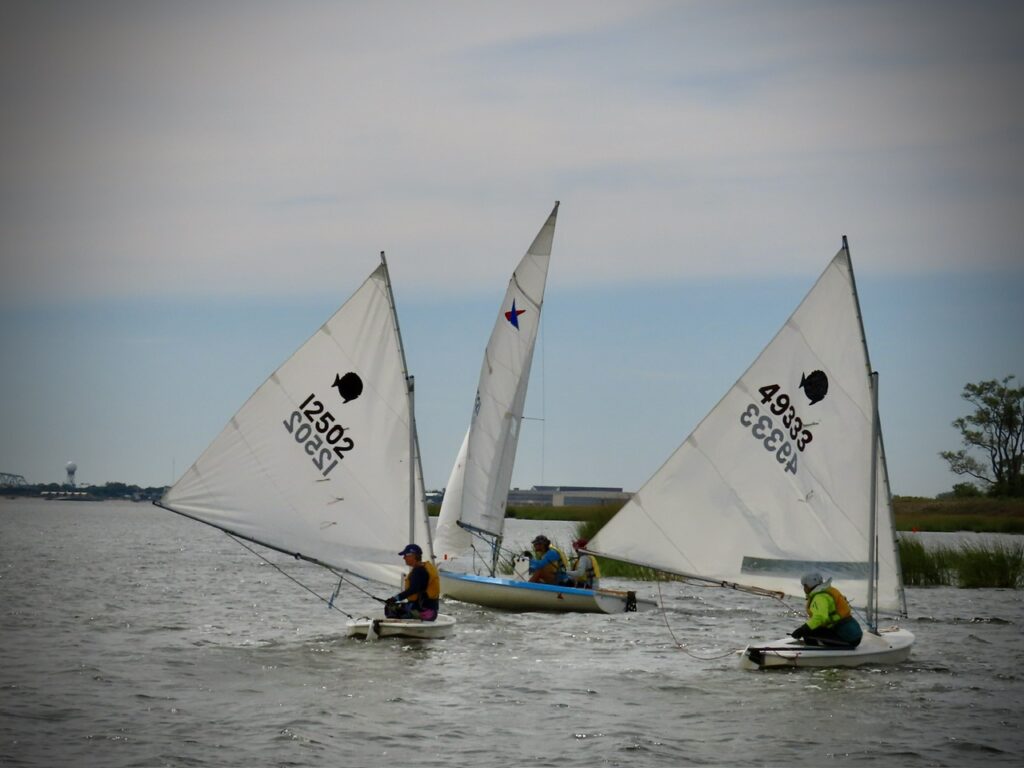
The course wasn’t around marks; it was a figure-8 around two island in Jamaica Bay. That’s tricky, as one has to decide how close to shore to go. Closer is often a shorter distance. But, that often means losing some wind, or running aground. Or both. Numerous boats ran aground at both islands. Jamaica Bay is deep in the middle channel going around most of it, but it’s quite shallow in other areas – even for little sailing dinghies.
We opted to follow the leaders and hedge our bets in the ’rounding’ parts of things, and observe. Good thing we watched; two people ground to a halt when they passed between two grass patches, giving us warning to raise our board all the way and heel over to protect the rudder and reduce leeway. That worked. Another two or three boats gained.
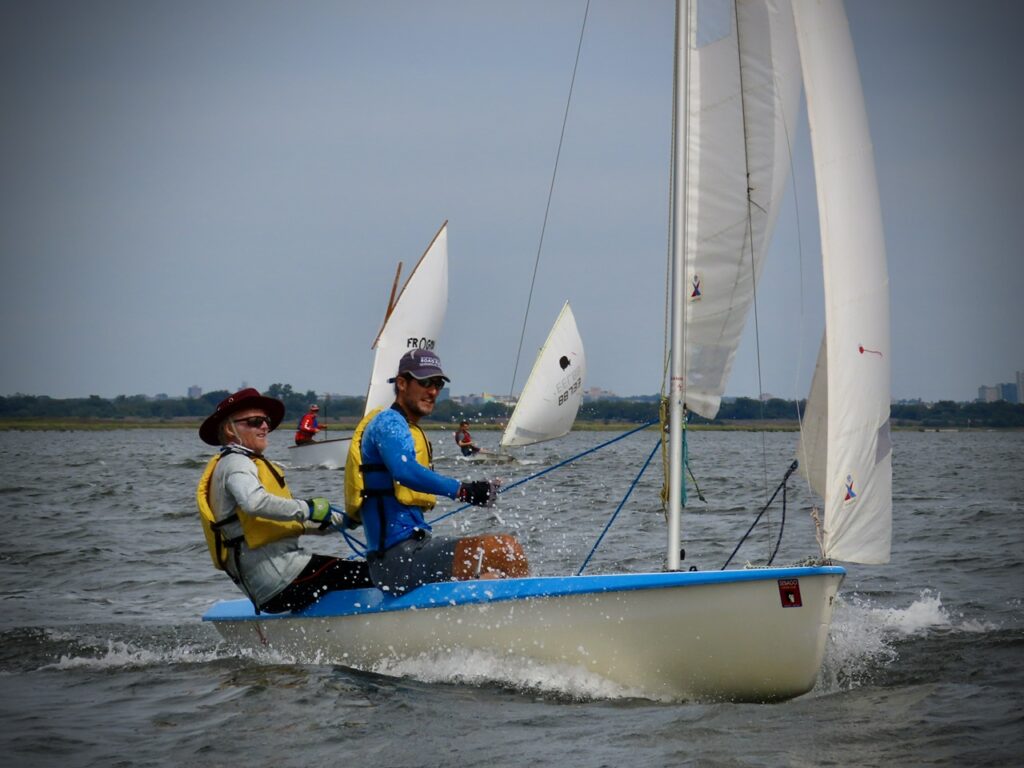
We had good speed for awhile on route to the next island, and felt more competitive. We traded places with one of the other Vanguards a few times, but after rounding the Ruffle Bar (second Island), they just left us behind. I’d counted on gaining ground upwind with hard hiking by Paolo and experienced reflexes playing the main in the gusts, but we just weren’t keeping up much less catching up.
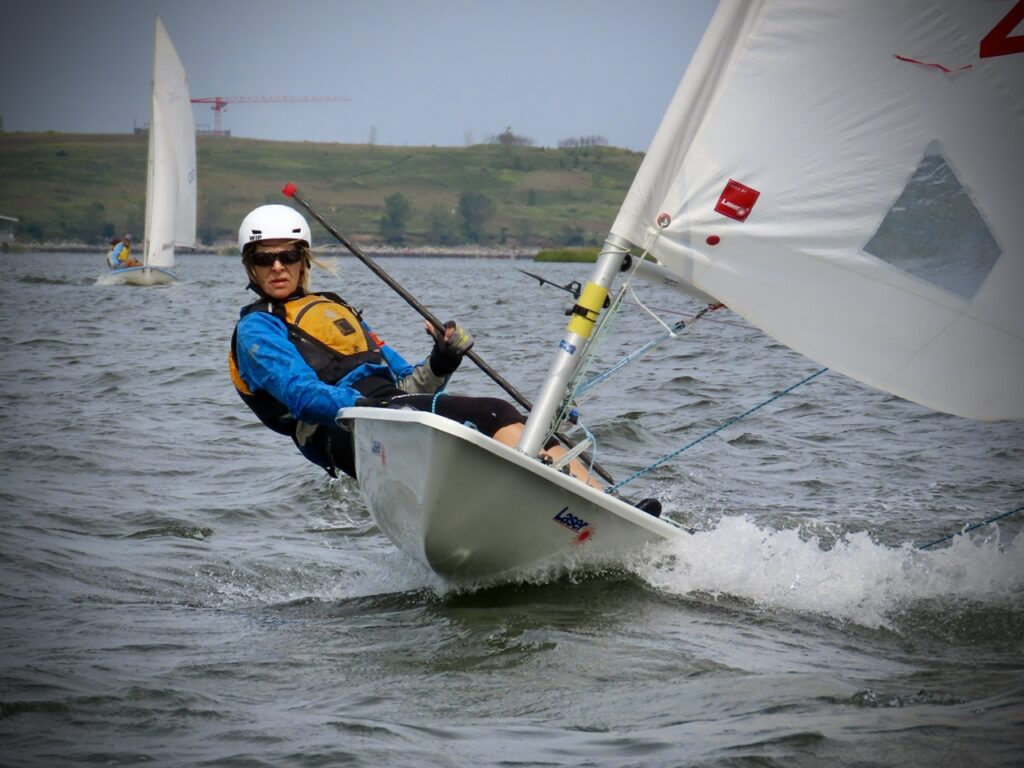
We sailed the rest of the upwind leg back to the finish trying to play the gusts and wind shifts, balancing two strategies: tacking when it would point us consistently closer to the finish, and conserving tacks. Our tacks sucked. Paolo wasn’t about to learn to roll tack in one race, and as well as handling the jib sheets, he had to hike out on the new side and also keep pushing the daggerboard back down as it tended to rise up. I was impressed at how he managed to multi task this. But, it was too much for a new dinghy sailor and we lost ground every tack. Half way through the upwind leg, I was underperforming in my duties as well. Tired.
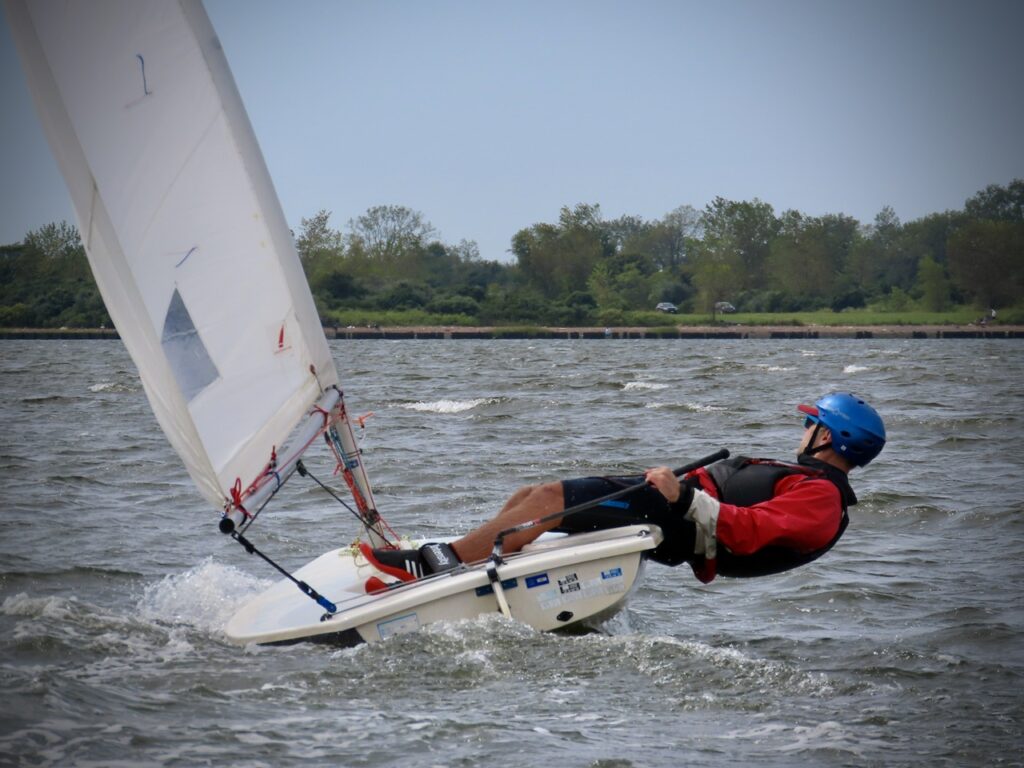
But, we kept our position relative to the two Laser Radials were were essentially ‘match’ racing against at that point, and eventually pulled ahead. We were in the upper third or so of the fleet, so at least we came back somewhat from our lame start.
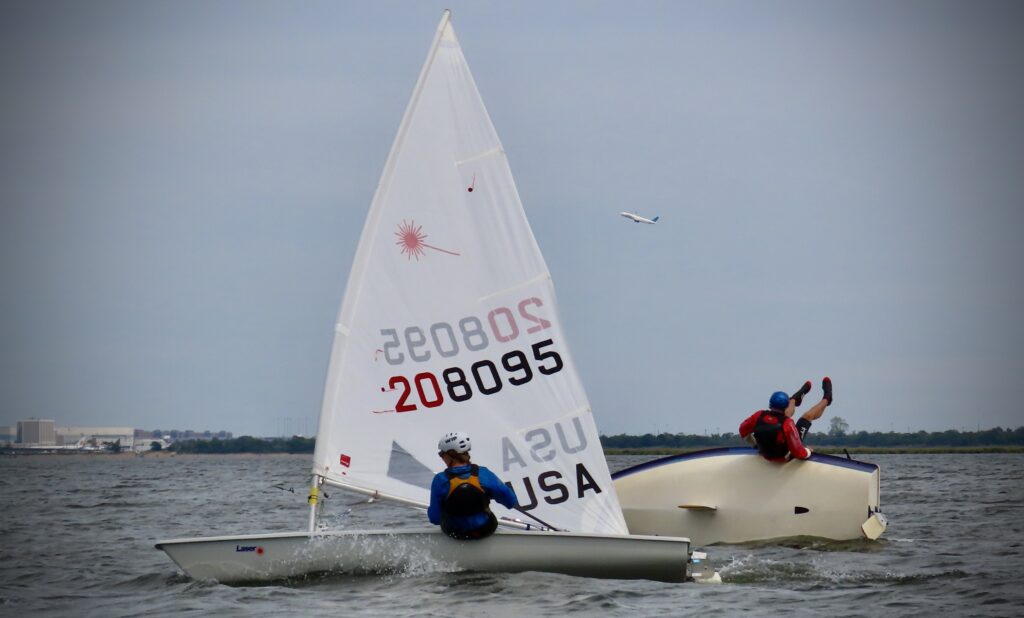
As soon as we finished, I capsized the boat! Not on purpose. But, capsize I did. I decided I wanted to jibe around the committe boat for the fun of it. Could have tacked. But, we’d had few jibes, and the wind was lighter. We jibed, the boat started heeling, it kept heeling, and then very gracefully finished heeling. 90 degrees. Sails flat on the water. I’d already jumped up on the windward rail, but Paolo went down with the ship, so to speak.
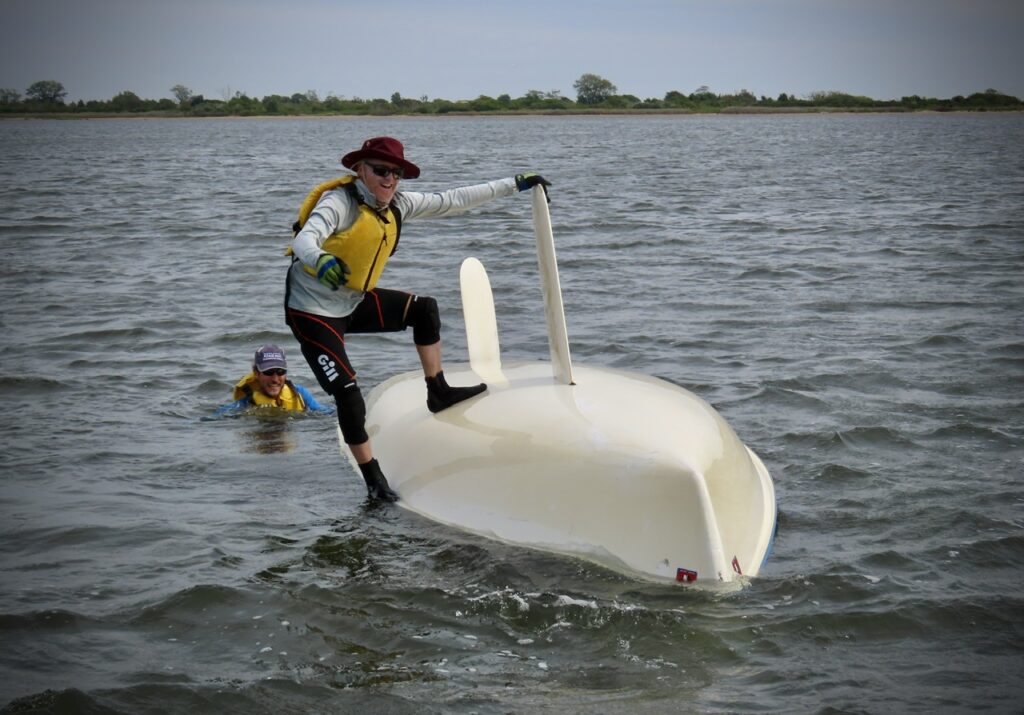
But wait – there’s more! The boat kept going. It ‘turtled:’ bottom and board up; sails straight down. Not uncommon. Not a drama. Got Paolo back to the boat, and we righted it quickly enough. Plenty of other boats had capsized during the actual race, including the man who was ahead the ENTIRE time and won line and corrected honors: David Cripton, a really solid Laser sailor. (I had that happen once in Manhasset Bay Race week but against a weaker field than at this Sebago Cup.)
Anywho, we got under the causeway that marks the entrance to the basin, feeling pretty good. Then, bam – ran aground again. Low tide; very common. But, it was a sudden, hard grounding, and the boat basically tripped over the board. Dinghy DOWN! We’d capsized again. This time, it was even less elegant, as we both went in the drink. But, it was waist deep for short me, so we just walked around the boat and flipped it. By then, Paolo was shivering from the two dunkings while I, with a little more body fat or possibly warmer layers, remained cool but okay. Short ride back, however, with no further flips.

Time to haul the boat out and up onto its dolly. It was heav-EEEEE. We were tired, of course, but this was TOO heavy. Then I realized. I never closed the drain plug on the transom before splashing the boat. I had checked it when I arrived at the boat; it had been left closed. So, I opened it to check for water, and a lot was coming out. I tipped the bow up on the dolly so it would drain. And, of course, forgot to close the plug.
We’d been taking water for two hours, and apparently faster than it could drain out the few times we got up on a plane. Embarrassing and silly way to slow down; not good for the boat – so even more embarrassing…
“So it goes.”
Kurt Vonnegut, over and over, in Slaughterhouse Five

We washed down the boat, left the sails up to dry, got into dry clothes, and finished putting the Vanguard to bed. Couldn’t wait for a beer! But we decided to wait until the banquet officially began. Someone else summarily decided they were hungry, and it was time, and that was that with that. A line formed and we all grabbed the grub: a variety of hot food and salads catered by Sebago and partially off set by our $10 entry fees, and some nice sides others brought on a volunteer basis (including Howard’s excellent vegan cole slaw). And, of course, a Voodoo Ranger Juicy Haze I brought to hedge against less-than-Stella beer I’d heard was common at the large events. So large that Paolo and I split one. (And, no – I don’t like Stella, but you saw what I did there.)
But, they had Lagunitas IPA and maybe some other good stuff, to my pleasant surprise. Good to know for future events!
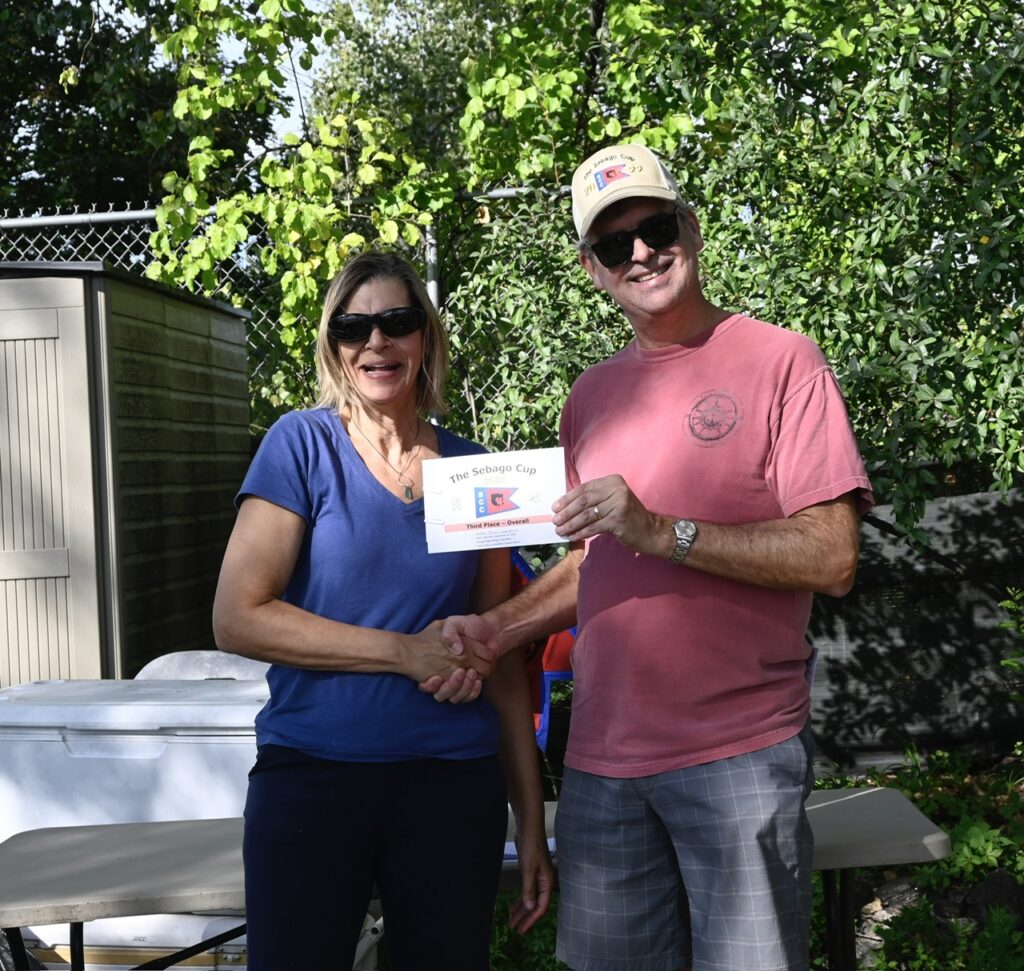
After chowing and chatting, the announcements and awards commenced. There were three Vanguards, and therefore a ‘class.’ that meant there was a 3rd place award. A Participation Award! Paolo and I could frame them, and simply not share that 3rd equalled last. LAST. DFL. (Use your imagination to decipher that acronym; it’s an old racing thing.)
I guess we… earned it?
It was a FUN time. I was in a buoyant mood for a day or two later despite a mediocre showing. Didn’t matter. I’d realized the best of what it meant to go racing: enjoy the camaraderie and like minded spirit of having fun trying to win a game. In this case, a dinghy race.
